Niche Evolution of China’s Provincial Social–Economic–Natural Complex Ecosystems, 2005–2015
Abstract
1. Introduction
2. Materials and Methods
2.1. Study Area and Data Sources
2.2. Construction of An Index System
2.3. A Full Permutation Polygon Synthetic Indicator Method
3. Results
3.1. Spatio-Temporal Dynamic Analysis of Each Subsystem’s Niche
3.1.1. Resource Niche
3.1.2. Environmental Niche
3.1.3. Economic Niche
3.1.4. Social Niche
3.2. Spatio-Temporal Dynamics of the Comprehensive Niche
3.2.1. Regional Comprehensive Niche Evolution
3.2.2. Coordinated Development of the Natural–Social–Economic System
4. Discussion
4.1. Global Spatial Autocorrelation of Regional Comprehensive Niche Indexes
4.2. Local Spatial Autocorrelation of Regional Comprehensive Niche Indexes
5. Conclusions
Author Contributions
Acknowledgments
Conflicts of Interest
Appendix A
References
- Kuang, W.; Liu, J.; Dong, J.; Chi, W.; Zhang, C. The rapid and massive urban and industrial land expansions in china between 1990 and 2010: A clud-based analysis of their trajectories, patterns, and drivers. Landsc. Urban Plan. 2016, 145, 21–33. [Google Scholar] [CrossRef]
- Jiang, Y.; Tian, Y.; Zheng, S. A study on urban ecosecurity pattern of island city:A case study of pingtan island. Acta Ecol. Sin. 2018, 38, 769–777. [Google Scholar]
- Yun, G.; Zuo, S.; Dai, S.; Song, X.; Xu, C.; Liao, Y.; Zhao, P.; Chang, W.; Chen, Q.; Li, Y. Individual and interactive influences of anthropogenic and ecological factors on forest pm2. 5 concentrations at an urban scale. Remote Sensing 2018, 10, 521. [Google Scholar] [CrossRef]
- Wang, Y.; Deng, X.; Marcucci, D.J.; Le, Y. Sustainable development planning of protected areas near cities: Case study in china. J. Urban Plan. Dev. 2012, 139, 133–143. [Google Scholar] [CrossRef]
- Wang, R.; Li, F.; Hu, D.; Larry Li, B. Understanding eco-complexity: Social-economic-natural complex ecosystem approach. Ecol. Complex. 2011, 8, 15–29. [Google Scholar] [CrossRef]
- Wang, J.; Song, P.; Zhang, B.; Liu, W.; Zhang, J. An ecological niche evaluation model of social, economic, and natural complex ecosystems: A case study in sichuan province. Acta Ecol. Sin. 2016, 20, 6628–6635. [Google Scholar] [CrossRef]
- Wang, R.; Ouyang, Z. Social-economic-natural complex ecosystem and sustainability. Bull. Chin. Acad. Sci. 2012, 27, 337–345. [Google Scholar]
- Han, B.; Wang, R.; Tao, Y.; Gao, H. Urban population agglomeration in view of complex ecological niche: A case study on chinese prefecture cities. Ecol. Indic. 2014, 47, 128–136. [Google Scholar] [CrossRef]
- Zhao, J.; Jia, H. Strategies for the sustainable development of lugu lake region. Int. J. Sustain. Dev. World Ecol. 2008, 15, 71–79. [Google Scholar] [CrossRef]
- Poveda, C.A. The theory of dimensional balance of needs. Int. J. Sustain. Dev. World Ecol. 2017, 24, 97–119. [Google Scholar] [CrossRef]
- Commission on Sustainable Development. Indicators of Sustainable Development: Guidelines and Methodologies; United Nations Department of Economic and Social Affairs: New York, NY, USA, 2001. [Google Scholar]
- Global Reporting Initiative (GRI). Sustainability Reporting Guidelines; Global Reporting Initiative: Amsterdam, The Netherlands, 2002. [Google Scholar]
- Organization for Economic Cooperation and Development (OECD). OECD Environmental Indicators: Towards Sustainable Development; OECD: Paris, France, 2001. [Google Scholar]
- Bolcárová, P.; Kološta, S. Assessment of sustainable development in the eu 27 using aggregated sd index. Ecol. Indic. 2015, 48, 699–705. [Google Scholar] [CrossRef]
- Grzebyk, M.; Stec, M. Sustainable development in eu countries: Concept and rating of levels of development. Sustain. Dev. 2015, 23, 110–123. [Google Scholar] [CrossRef]
- Palme, U.; Tillman, A.-M. Sustainable development indicators: How are they used in swedish water utilities? J. Clean. Prod. 2008, 16, 1346–1357. [Google Scholar] [CrossRef]
- Steurer, R.; Hametner, M. Objectives and indicators in sustainable development strategies: Similarities and variances across europe. Sustain. Dev. 2013, 21, 224–241. [Google Scholar] [CrossRef]
- Ledoux, L.; Mertens, R.; Wolff, P. EU sustainable development indicators: An overview. In Natural Resources Forum; Blackwell Publishing Ltd.: Oxford, UK, 2005. [Google Scholar]
- Wong, T.; Yuen, B.; Goldblum, C. Spatial Planning for a Sustainable Singapore; Springer: Dordrecht, The Netherlands, 2008. [Google Scholar]
- Sharifi, A.; Murayama, A. Neighborhood sustainability assessment in action: Cross-evaluation of three assessment systems and their cases from the us, the uk, and japan. Build. Environ. 2014, 72, 243–258. [Google Scholar] [CrossRef]
- Zinatizadeh, S.; Azmi, A.; Monavari, S.M.; Sobhanardakani, S. Evaluation and prediction of sustainability of urban areas: A case study for kermanshah city, iran. Cities. 2017, 66, 1–9. [Google Scholar] [CrossRef]
- Beynen, P.V.; Akiwumi, F.A.; Beynen, K.V. A sustainability index for small island developing states. Int. J. Sustain. Dev. World Ecol. 2017, 1–18. [Google Scholar] [CrossRef]
- Institute of Urban Environment (IUE). Report of China’s Sustainable Urban Development in 2010; Press of Social Science: Beijing, China, 2010. [Google Scholar]
- National Development and Reform Commission (NDRC). National and Regional Outline of the Twelfth Five-Year Plan for Economic and Social Development; People’s Publishing House: Beijing, China, 2011.
- Beijing Municipal Commission Development and Reform (BMCDR). Green Beijing Construction Planning during the Twelve Five-Year Plan; Beijing Municipal Commission Development and Reform: Beijing, China, 2011.
- Sun, X.; Liu, X.; Li, F.; Tao, Y.; Song, Y. Comprehensive evaluation of different scale cities’ sustainable development for economy, society, and ecological infrastructure in china. J. Clean. Prod. 2015. [Google Scholar] [CrossRef]
- Ding, L.; Shao, Z.; Zhang, H.; Xu, C.; Wu, D. A comprehensive evaluation of urban sustainable development in china based on the topsis-entropy method. Sustainability. 2016, 8, 746. [Google Scholar] [CrossRef]
- Wu, H.; Yu, Y.; Li, S.; Huang, K. An empirical study of the assessment of green development in beijing, China: Considering resource depletion, environmental damage and ecological benefits simultaneously. Sustainability. 2018, 10, 719. [Google Scholar] [CrossRef]
- Yu, L. Low carbon eco-city: New approach for chinese urbanisation. Habitat Int. 2014, 44, 102–110. [Google Scholar] [CrossRef]
- Phillis, Y.A.; Kouikoglou, V.S.; Verdugo, C. Urban sustainability assessment and ranking of cities. Comput. Environ. Urban Syst. 2017, 64, 254–265. [Google Scholar] [CrossRef]
- Liu, L. A sustainability index with attention to environmental justice for eco-city classification and assessment. Ecol. Indic. 2018, 85, 904–914. [Google Scholar] [CrossRef]
- Liu, M.C.; Liu, X.C.; Yang, Z.S. An integrated indicator on regional ecological civilization construction in china. Int. J. Sustain. Dev. World Ecol. 2016, 23, 53–60. [Google Scholar] [CrossRef]
- Shi, L.; Vause, J.; Gao, L.; Li, Q.; Tang, L. Temporal changes in sustainable development level for lijiang city: 2003–2008. Int. J. Sustain. Dev. World Ecol. 2011, 18, 474–479. [Google Scholar] [CrossRef]
- Yan, Y.; Wang, C.; Quan, Y.; Wu, G.; Zhao, J. Urban sustainable development efficiency towards the balance between nature and human well-being: Connotation, measurement, and assessment. J. Clean. Prod. 2018, 178, 67–75. [Google Scholar] [CrossRef]
- Lu, C.; Xue, B.; Lu, C.; Wang, T.; Jiang, L.; Zhang, Z.; Ren, W. Sustainability investigation of resource-based cities in northeastern china. Sustainability 2016, 8, 1058. [Google Scholar] [CrossRef]
- Deng, H.; Liu, T.; Zhao, J. Strategic measures for an integrated approach to sustainable development in lijiang city. Int. J. Sustain. Dev. World Ecol. 2011, 18, 559–562. [Google Scholar] [CrossRef]
- Zhang, M.; Tan, F.; Lu, Z. Resource-based cities (rbc): A road to sustainability. Int. J. Sustain. Dev. World Ecol. 2014, 21, 465–470. [Google Scholar] [CrossRef]
- Fernandes, I.D.; Ferreira, F.A.; Bento, P.; Jalali, M.S.; António, N.J. Assessing sustainable development in urban areas using cognitive mapping and mcda. Int. J. Sustain. Dev. World Ecol. 2018, 25, 216–226. [Google Scholar] [CrossRef]
- Zhou, D.; Xu, J.; Wang, L.; Lin, Z. Assessing urbanization quality using structure and function analyses: A case study of the urban agglomeration around hangzhou bay (uahb), China. Habitat Int. 2015, 49, 165–176. [Google Scholar] [CrossRef]
- Wang, Q.; Yuan, X.; Cheng, X.; Mu, R.; Zuo, J. Coordinated development of energy, economy and environment subsystems—A case study. Ecol. Indic. 2014, 46, 514–523. [Google Scholar] [CrossRef]
- Tan, F.; Lu, Z. Assessing regional sustainable development through an integration of nonlinear principal component analysis and gram schmidt orthogonalization. Ecol. Indic. 2016, 63, 71–81. [Google Scholar] [CrossRef]
- Zhan, S.F.; Zhang, X.C.; Ma, C.; Chen, W.P. Dynamic modelling for ecological and economic sustainability in a rapid urbanizing region. Procedia Environ. Sci. 2012, 13, 242–251. [Google Scholar] [CrossRef]
- Singh, R.K.; Murty, H.R.; Gupta, S.K.; Dikshit, A.K. An overview of sustainability assessment methodologies. Ecol. Indic. 2012, 15, 281–299. [Google Scholar] [CrossRef]
- Cai, C.; Shang, J. Comprehensive evaluation on urban sustainable development of harbin city in northeast china. Chin. Geogr. Sci. 2009, 19, 144–150. [Google Scholar] [CrossRef]
- Wu, H.-Q.; Shi, Y.; Xia, Q.; Zhu, W.-D. Effectiveness of the policy of circular economy in china: A dea-based analysis for the period of 11th five-year-plan. Resour. Conserv. Recycl. 2014, 83, 163–175. [Google Scholar] [CrossRef]
- Li, H.; Fang, K.; Yang, W.; Wang, D.; Hong, X. Regional environmental efficiency evaluation in china: Analysis based on the super-sbm model with undesirable outputs. Math. Comput. Model. 2013, 58, 1018–1031. [Google Scholar] [CrossRef]
- Jia, J.; Fan, Y.; Guo, X. The low carbon development (lcd) levels’ evaluation of the world’s 47 countries (areas) by combining the fahp with the topsis method. Expert Syst. Appl. 2012, 39, 6628–6640. [Google Scholar] [CrossRef]
- Geng, Y.; Zhang, L.; Chen, X.; Xue, B.; Fujita, T.; Dong, H. Urban ecological footprint analysis: A comparative study between shenyang in china and kawasaki in japan. J. Clean. Prod. 2014, 75, 130–142. [Google Scholar] [CrossRef]
- Musa, H.D.; Yacob, M.R.; Abdullah, A.M.; Ishak, M.Y. Delphi method of developing environmental well-being indicators for the evaluation of urban sustainability in malaysia. Procedia Environ. Sci. 2015, 30, 244–249. [Google Scholar] [CrossRef]
- Li, F.; Liu, X.; Hu, D.; Wang, R.; Yang, W.; Li, D.; Zhao, D. Measurement indicators and an evaluation approach for assessing urban sustainable development: A case study for china’s jining city. Landsc. Urban Plan. 2009, 90, 134–142. [Google Scholar] [CrossRef]
- Tao, Y.; Li, F.; Crittenden, J.C.; Lu, Z.; Sun, X. Environmental impacts of china’s urbanization from 2000 to 2010 and management implications. Environ. Manage. 2016, 57, 498–507. [Google Scholar] [CrossRef] [PubMed]
- Choon, S.-W.; Siwar, C.; Pereira, J.J.; Jemain, A.A. A sustainable city index for malaysia. Int. J. Sustain. Dev. World Ecol. 2011, 18, 28–35. [Google Scholar] [CrossRef]
- Ghalib, A.; Qadir, A.; Ahmad, S.R. Evaluation of developmental progress in some cities of punjab, pakistan, using urban sustainability indicators. Sustainability. 2017, 9. [Google Scholar]
- Wan, N.F.; Zhang, M.Y.; Jiang, J.X.; Ji, X.Y.; Hao-Zhang. An ecological method to understand agricultural standardization in peach orchard ecosystems. Sci. Rep. 2016, 6, 21675. [Google Scholar] [CrossRef] [PubMed]
- Xu, C.; Wang, S.; Zhou, Y.; Wang, L.; Liu, W. A comprehensive quantitative evaluation of new sustainable urbanization level in 20 chinese urban agglomerations. Sustainability. 2016, 8, 91. [Google Scholar] [CrossRef]
- Wang, G.; Wang, M.; Wang, J.; Yang, C. Spatio-temporal characteristics of rural economic development in eastern coastal china. Sustainability 2015, 7, 1542–1557. [Google Scholar] [CrossRef]
- Yin, K.; Wang, R.; An, Q.; Yao, L.; Liang, J. Using eco-efficiency as an indicator for sustainable urban development: A case study of chinese provincial capital cities. Ecol. Indic. 2014, 36, 665–671. [Google Scholar] [CrossRef]
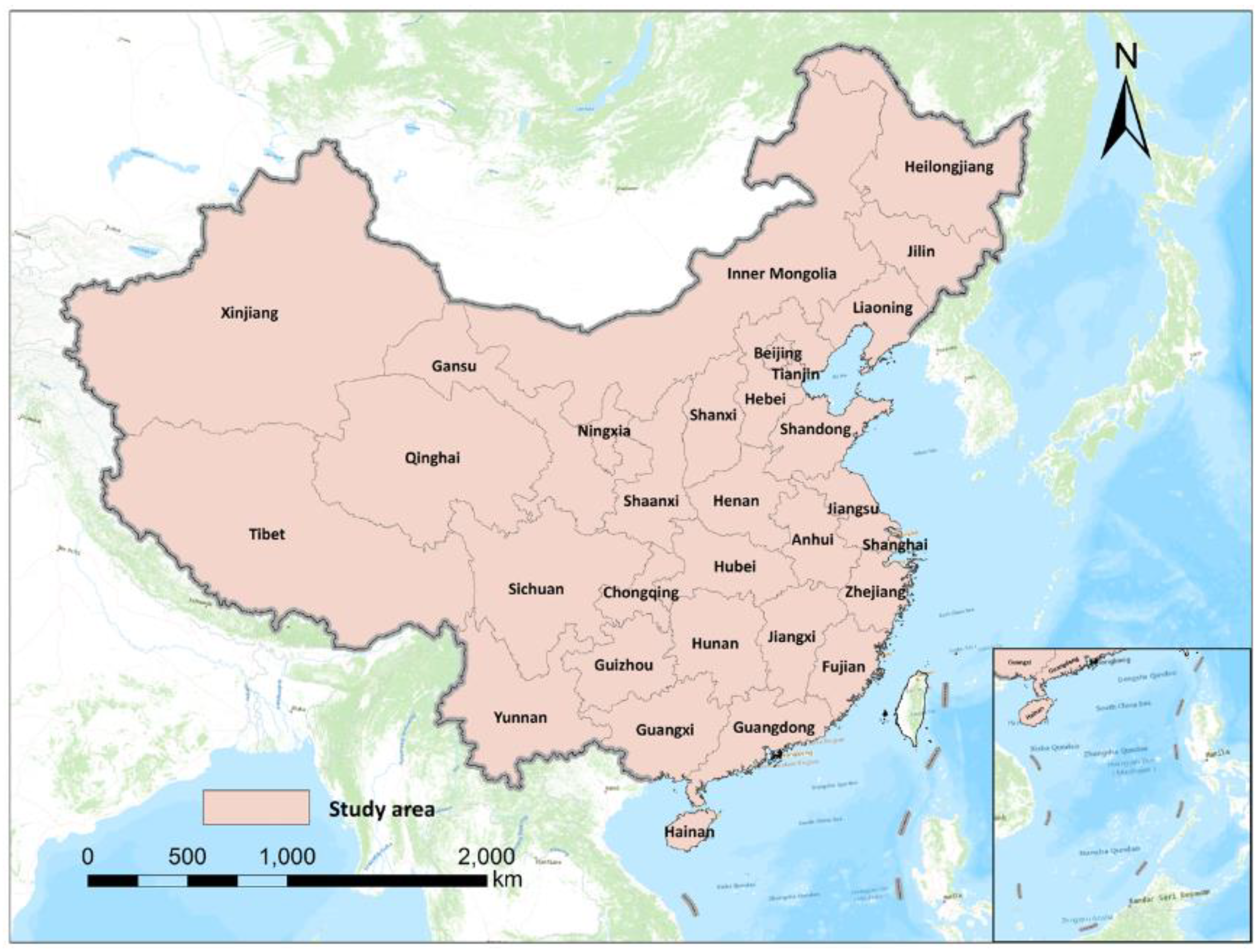
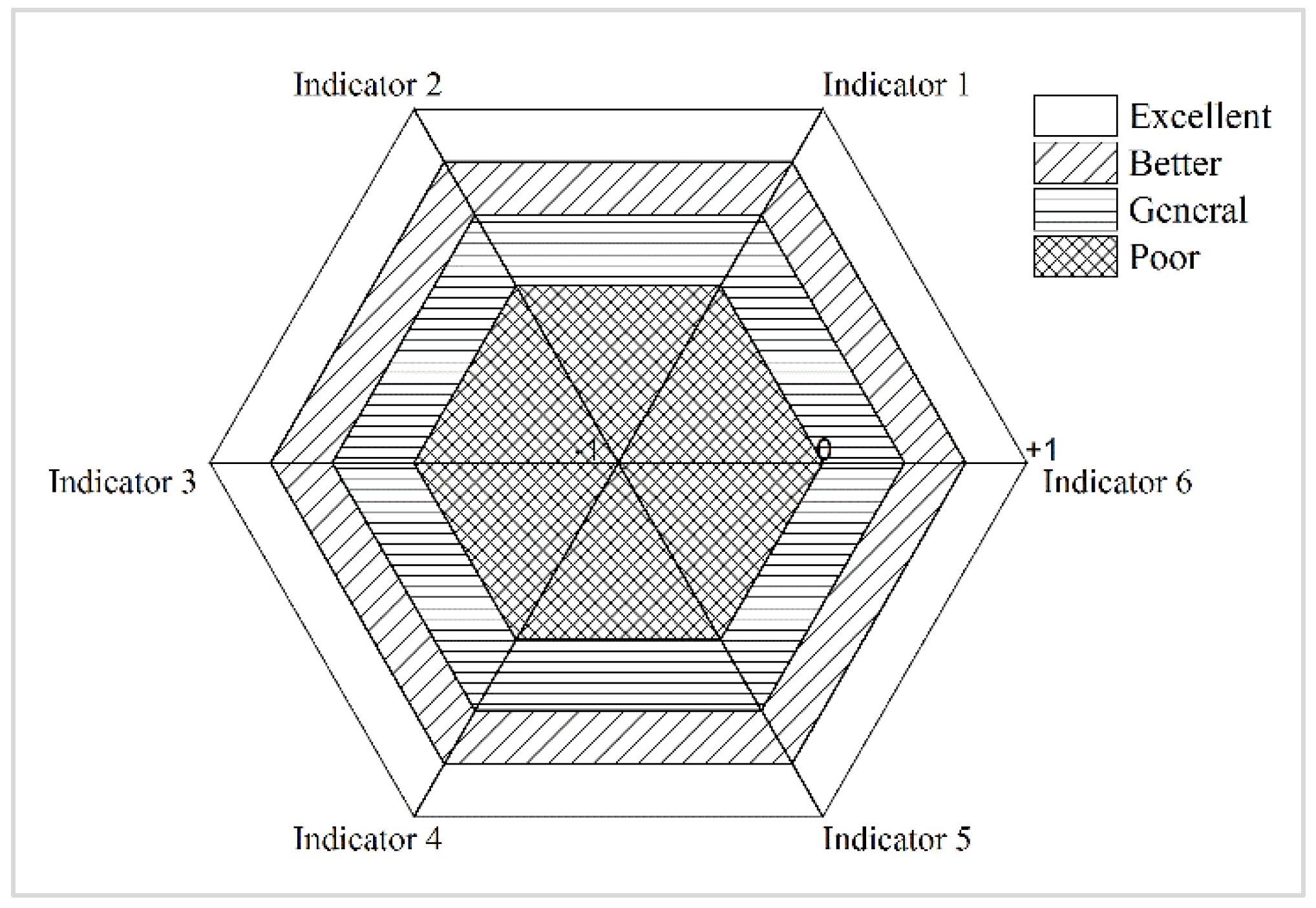
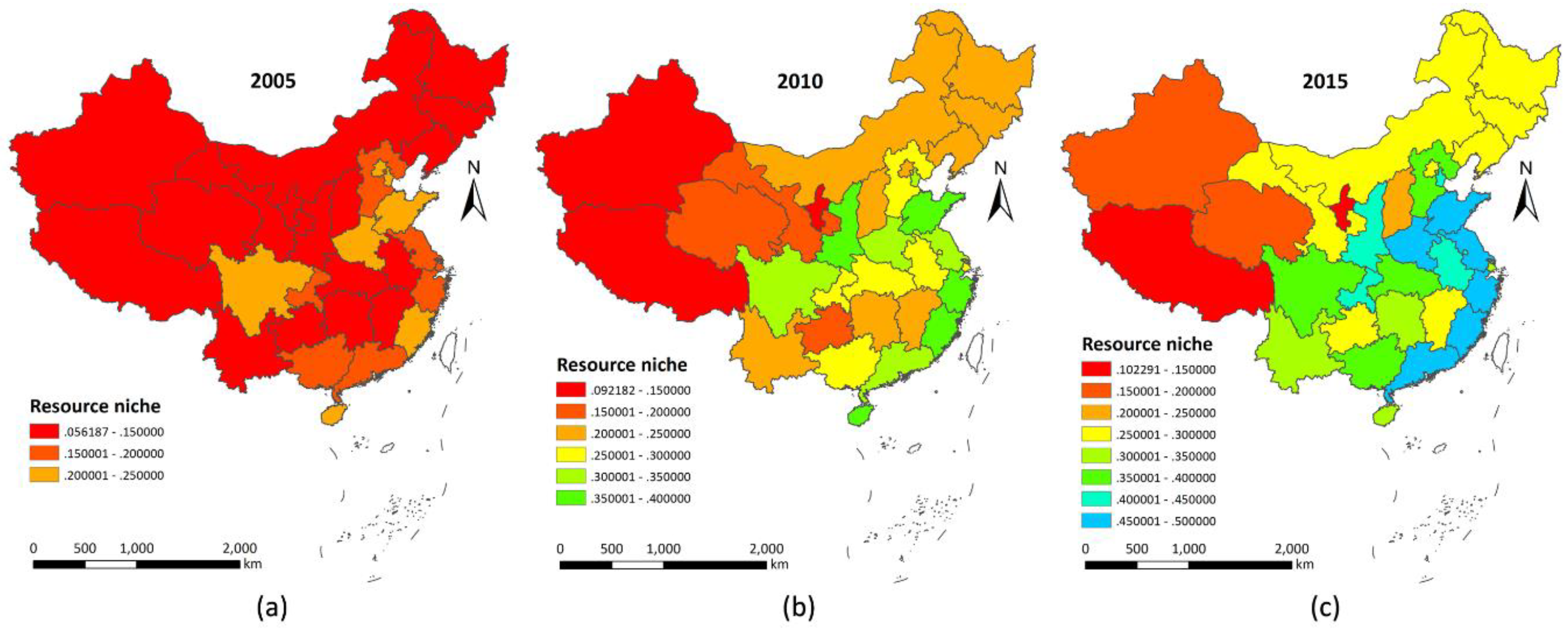
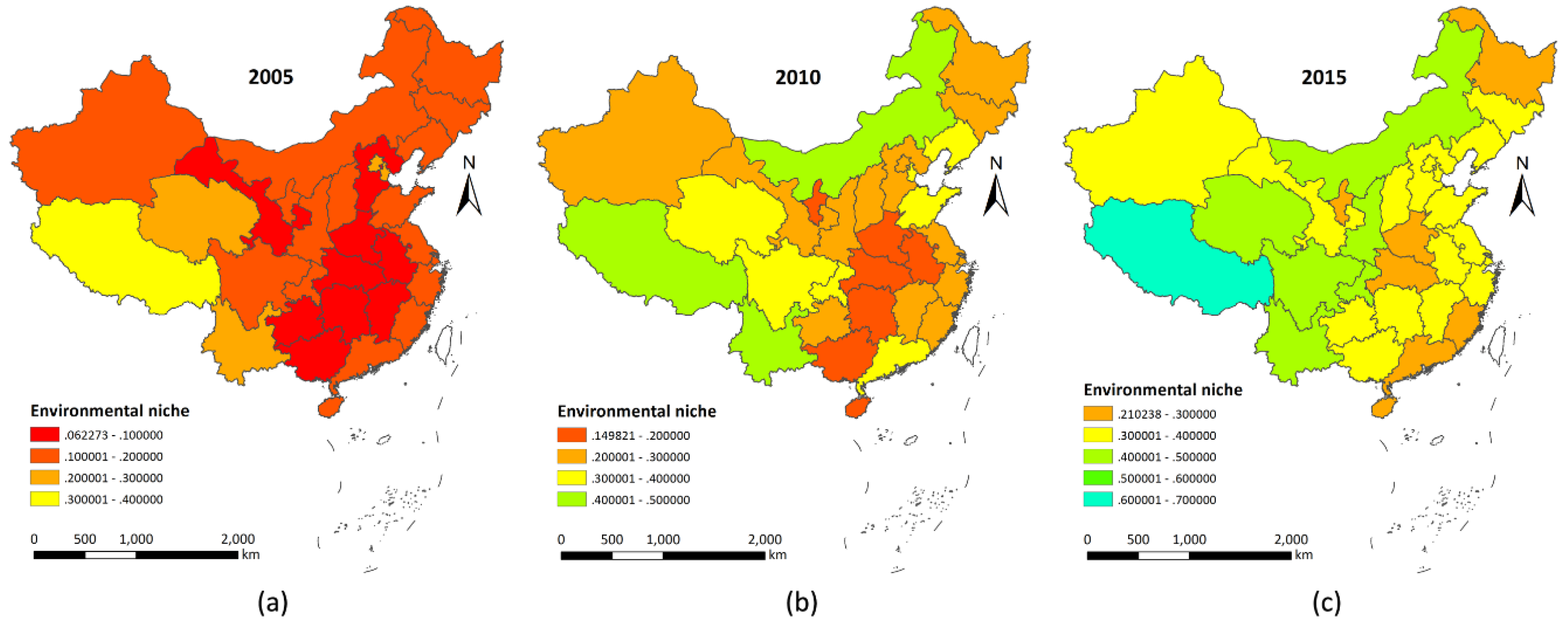
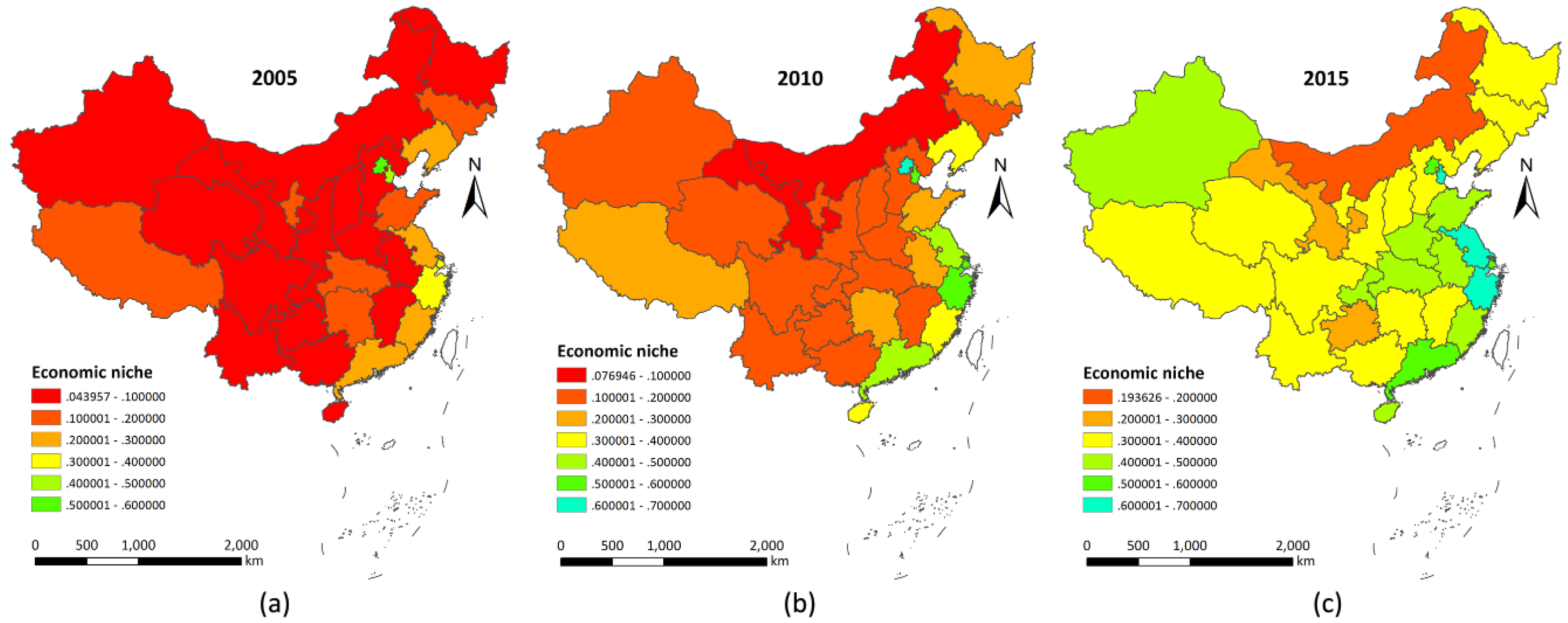
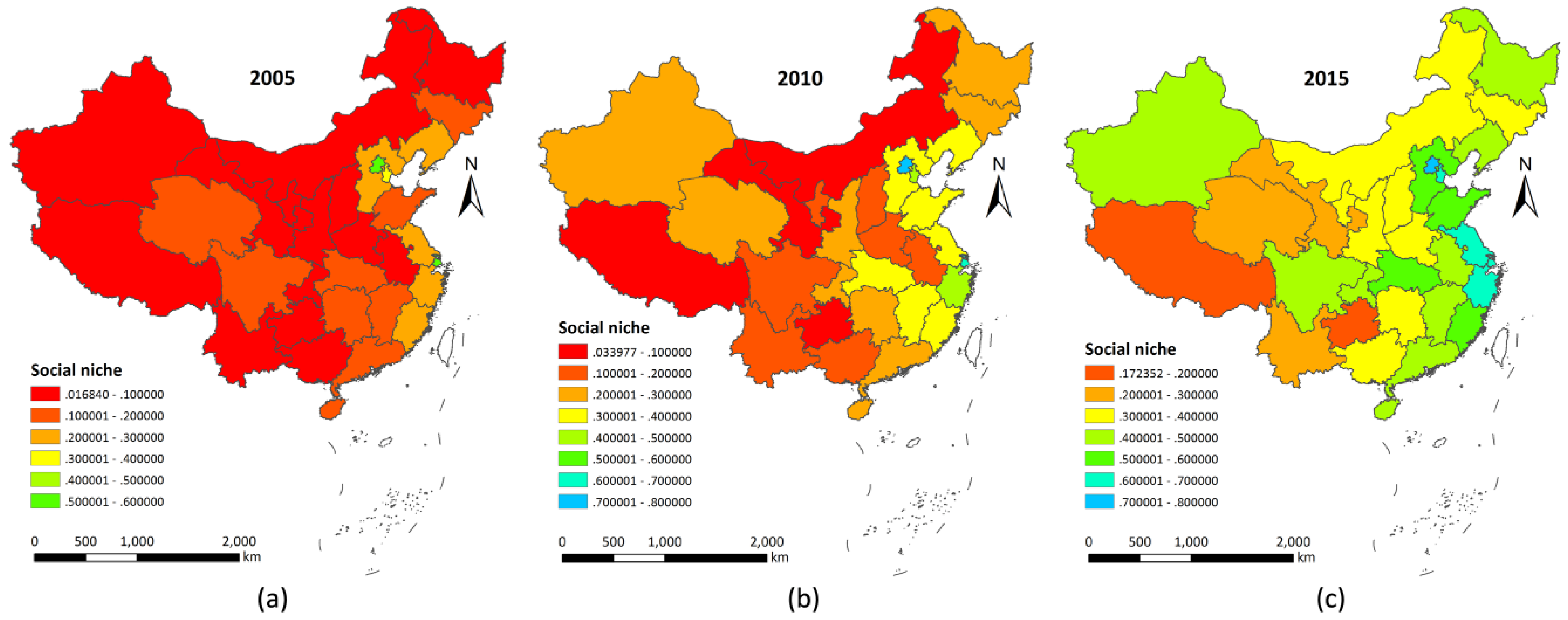

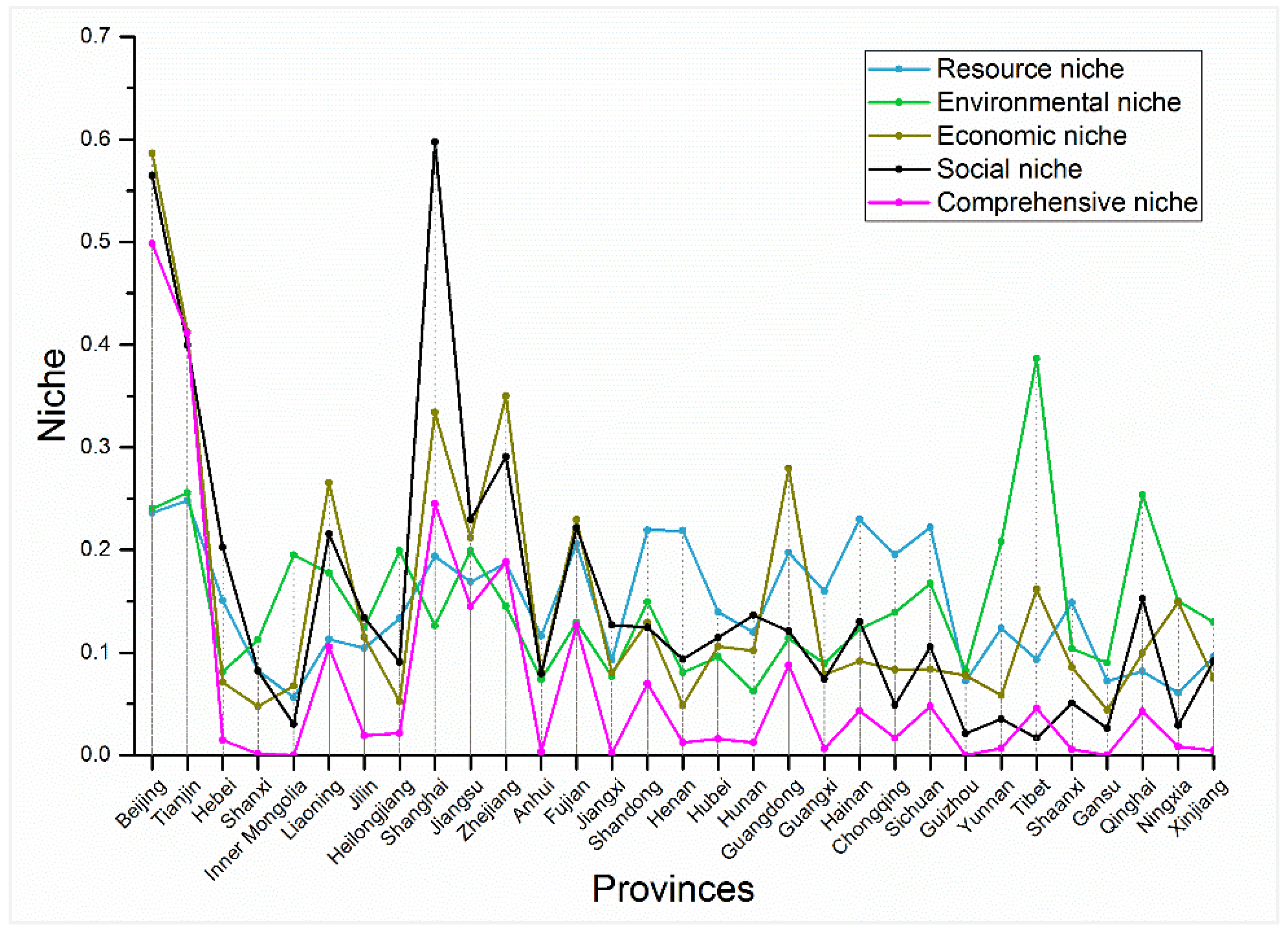
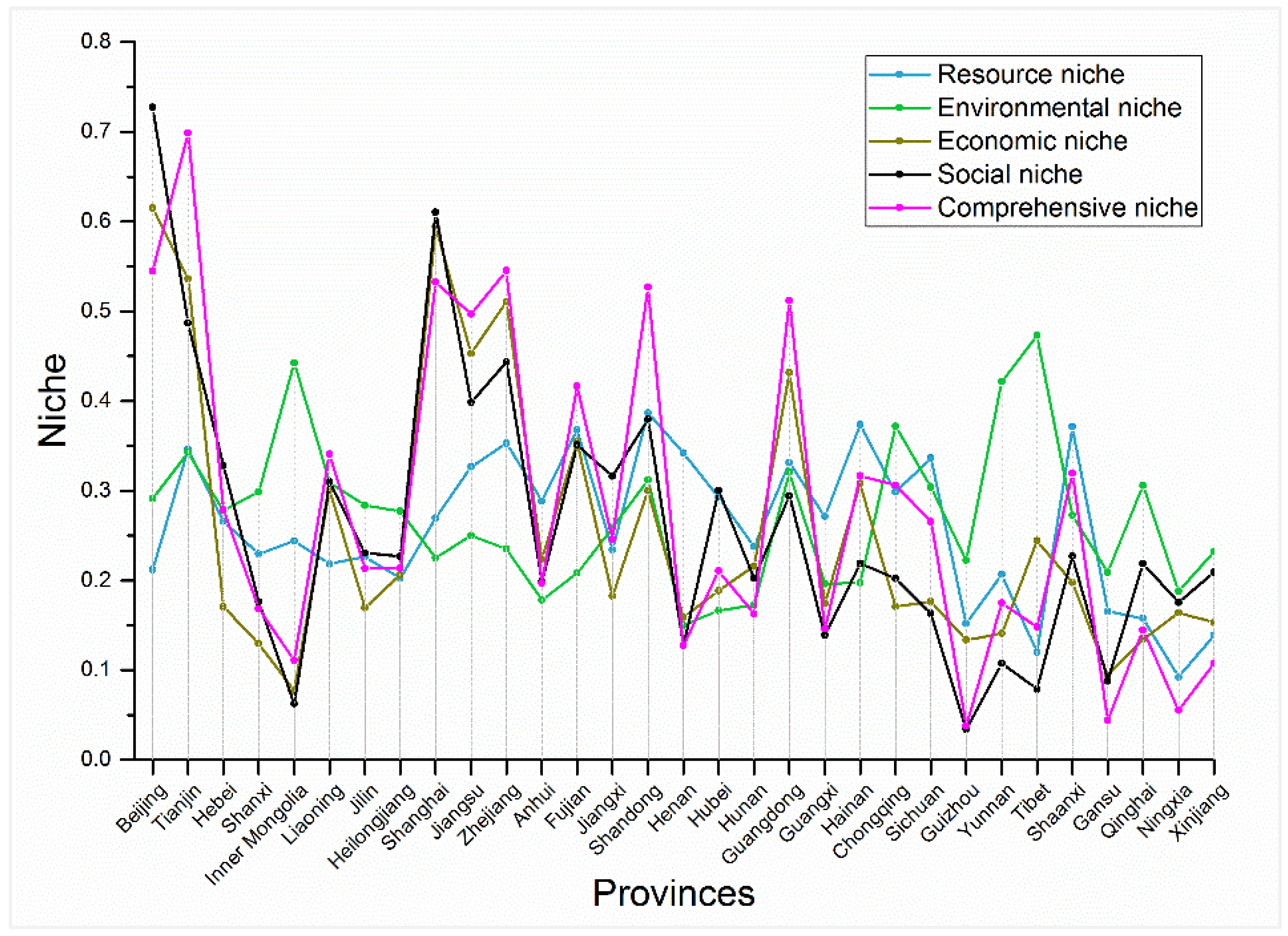
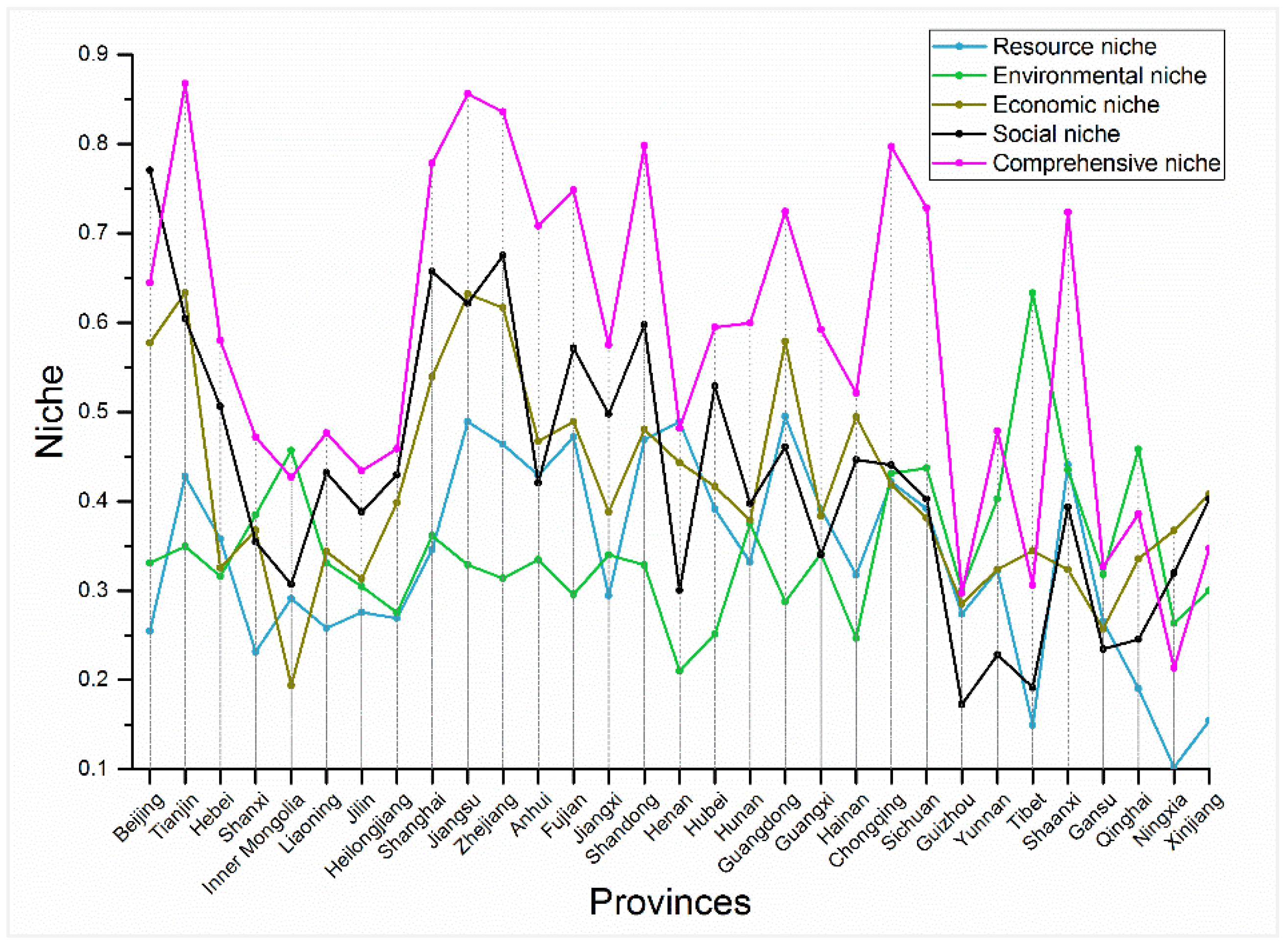
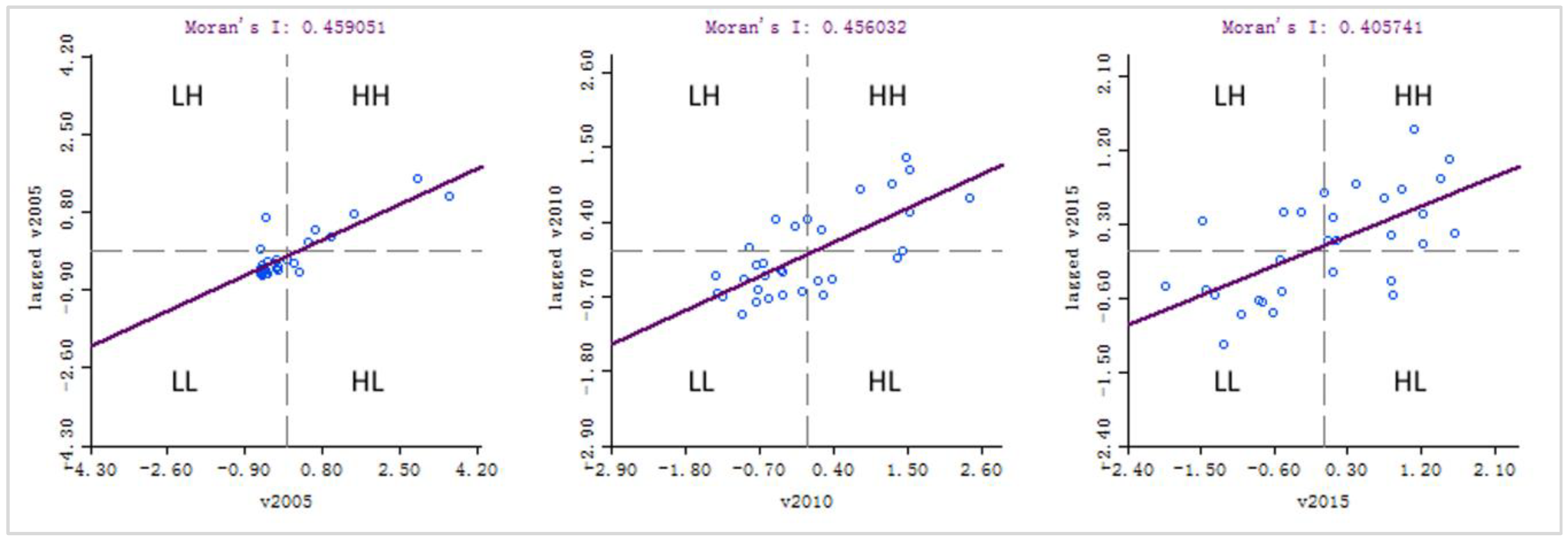
| Target Layer | Sub-Target Layer | Indicator Layer | Properties |
|---|---|---|---|
| Comprehensive ecological niche of a complex ecosystem | Resource niche | Per capita arable land area (hm²/person) | Positive |
| Per capita water sources (m3/person) | Positive | ||
| Energy consumption per unit of gross domestic product (GDP) (t standard coal/10,000 yuan) | Negative | ||
| Water consumption per unit of GDP (m3/10,000 yuan) | Negative | ||
| Unit land output value (100 million yuan/km²) | Positive | ||
| Clean energy use proportion (%) | Positive | ||
| Biogas production in rural area | Positive | ||
| Industrial water reuse rate (%) | Positive | ||
| Comprehensive utilization of industrial solid waste (%) | Positive | ||
| Environmental niche | Forest reserve (m³/ person) | Positive | |
| Wetland coverage (%) | Positive | ||
| Natural reserves as a percentage of area (%) | Positive | ||
| Investment in prevention and control of geological disasters as a percentage of GDP (%) | Positive | ||
| Sulfur dioxide emission intensity per unit of GDP (t/ten thousand yuan) | Negative | ||
| Chemical oxygen demand emission intensity per unit of GDP (t/ten thousand yuan) | Negative | ||
| Regional ambient noise quality (dB) | Negative | ||
| Pesticide use per unit of cultivated land area (t/hm²) | Negative | ||
| Sewage centralized treatment rate (%) | Positive | ||
| Innocuous treatment rate of domestic waste (%) | Positive | ||
| Proportion of investment in environmental pollution control of GDP (%) | Positive | ||
| Economical niche | Per capita GDP (Million yuan/person) | Positive | |
| Proportion of fiscal expenditure on science and technology of GDP (%) | Positive | ||
| Patents authorized per 10000 person (item/10,000 person) | Positive | ||
| Tertiary industry added value of GDP (%) | Positive | ||
| High and new technology industry output of GDP (%) | Positive | ||
| Agricultural mechanization level (10,000 kW/10,000 ha) | Positive | ||
| Dual contrast coefficient | Positive | ||
| Final consumption rate (%) | Positive | ||
| Capital formation rate (%) | Positive | ||
| Total value of import and export trade per capita (dollar/person) | Positive | ||
| Social niche | Educational investment of GDP (%) | Positive | |
| Health technician per 1000 persons (person) | Positive | ||
| Average life expectancy (year) | Positive | ||
| Proportion of social security and employment expenditure of total government financial expenditure (%) | Positive | ||
| Urban–rural resident income ratio | Negative | ||
| Per capita housing area of rural residents (m²/person) | Positive | ||
| Green space rate of urban built-up region (%) | Positive | ||
| Urban gas usage rate (%) | Positive | ||
| Urban water usage rate (%) | Positive | ||
| Cumulative benefit rate of rural water diversion (%) | Positive | ||
| Usage rate of sanitary latrines in rural areas (%) | Positive | ||
| Public transport use (vehicles per 10,000 persons) | Positive |
| Level | Range of Values | Niche Level |
|---|---|---|
| I | >0.75 | Excellent |
| II | 0.5−0.75 | Better |
| III | 0.25−0.5 | General |
| IV | <0.25 | Poor |
| Year | 2005 | 2010 | 2015 |
|---|---|---|---|
| Moran’s Index | 0.459 | 0.456 | 0.406 |
| Z Score | 4.931 | 4.178 | 3.721 |
| P Value | 0.001 | 0.001 | 0.002 |
© 2018 by the authors. Licensee MDPI, Basel, Switzerland. This article is an open access article distributed under the terms and conditions of the Creative Commons Attribution (CC BY) license (http://creativecommons.org/licenses/by/4.0/).
Share and Cite
Jiang, Y.; Sun, S.; Wang, Y.; Zheng, S. Niche Evolution of China’s Provincial Social–Economic–Natural Complex Ecosystems, 2005–2015. Sustainability 2018, 10, 2824. https://doi.org/10.3390/su10082824
Jiang Y, Sun S, Wang Y, Zheng S. Niche Evolution of China’s Provincial Social–Economic–Natural Complex Ecosystems, 2005–2015. Sustainability. 2018; 10(8):2824. https://doi.org/10.3390/su10082824
Chicago/Turabian StyleJiang, Yuantong, Shoukai Sun, Yening Wang, and Shuanning Zheng. 2018. "Niche Evolution of China’s Provincial Social–Economic–Natural Complex Ecosystems, 2005–2015" Sustainability 10, no. 8: 2824. https://doi.org/10.3390/su10082824
APA StyleJiang, Y., Sun, S., Wang, Y., & Zheng, S. (2018). Niche Evolution of China’s Provincial Social–Economic–Natural Complex Ecosystems, 2005–2015. Sustainability, 10(8), 2824. https://doi.org/10.3390/su10082824





